Mount Russell - Northeast Couloir
High Angle Skiing on a California Fourteener
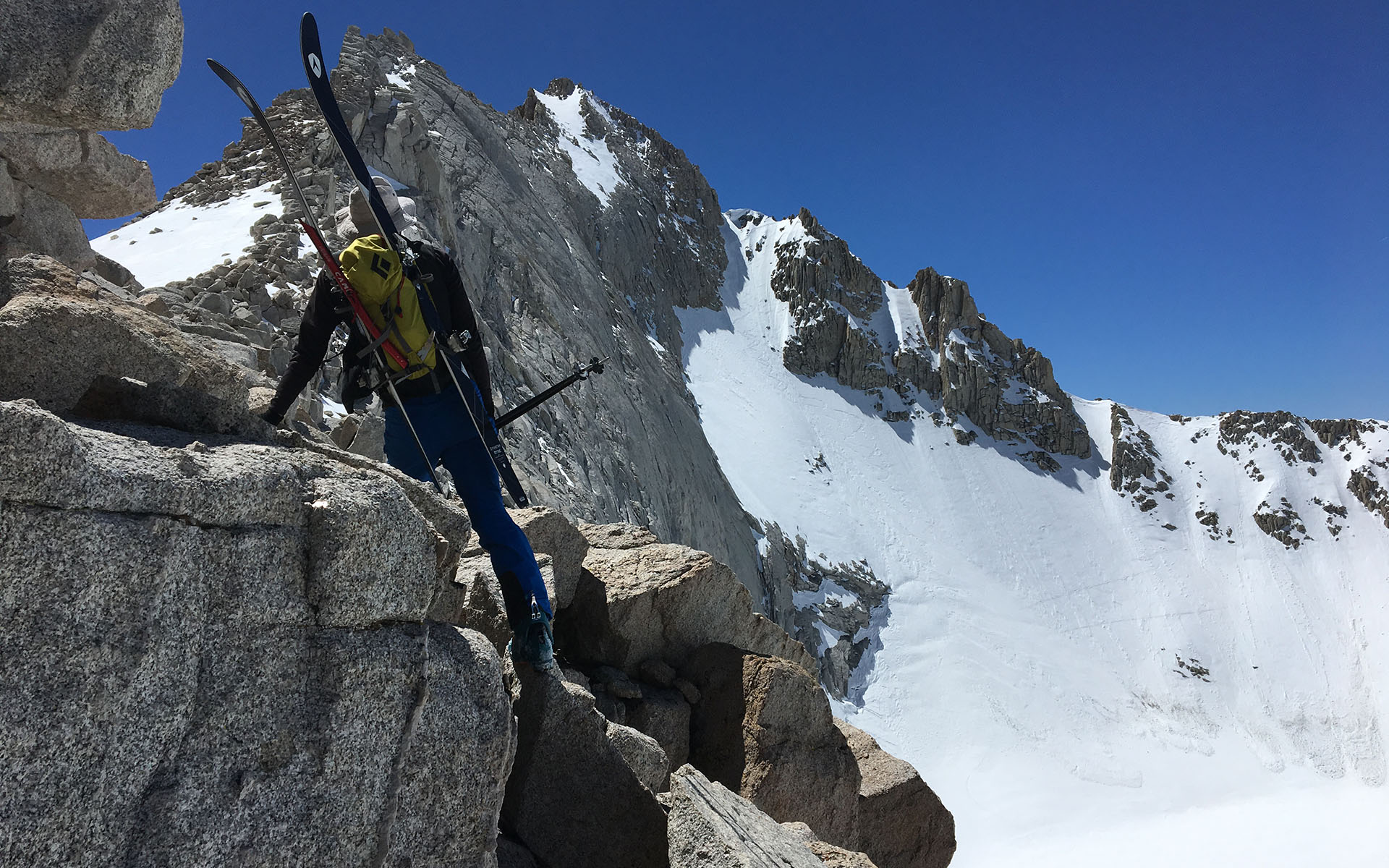
Mount Russell, California — Big winters bring big lines. When the storms clear, that's the allure: break out the binoculars or the long lens, gaze upward, focus in, and ask yourself, what's out there?
One such avenue of possibility is staring at my ski partner Preston and I right now, and it's a doozy. We are scrambling down loose blocky talus on the headwall below Russell-Carillon col. Mount Russell's incomparable east ridge rises before us like a massive and serrated blade of granite, dominating the horizon.
Just below the east ridge, dead ahead, is a brilliant, gleaming white wall. You don't have to know—as I do—that in summer virtually that entire wall is one massive cliff. No, even here today, covered in snow, the steepness of that wall is self-evident.
Or is it?
This is the magic—or madness—of a big winter. What ought to be sheer and merciless rock is instead a curiously-angled curtain of snow. It is possible, even easy, looking at that white wall, to see only the snow and to forget the reality of the cliff. But the cliff is there, whether or not you see it.
I promise you that.
As I stare at it now, the skier and the climber in me are in a heated dispute, each side arguing its case. The skier of course wants to ski that wall because skiing is what we do. But the climber remembers that wall in summer and, in an increasingly shrill voice, insists that is no ordinary snowfield.
Preston, meanwhile, is stoked. And his enthusiasm tips the balance in the skier's favor. Let's get a little closer, I tell my two selves, take a look. No harm in looking. Maybe we'll climb halfway up the wall, ski it from there. No harm in that, right?
Introspection
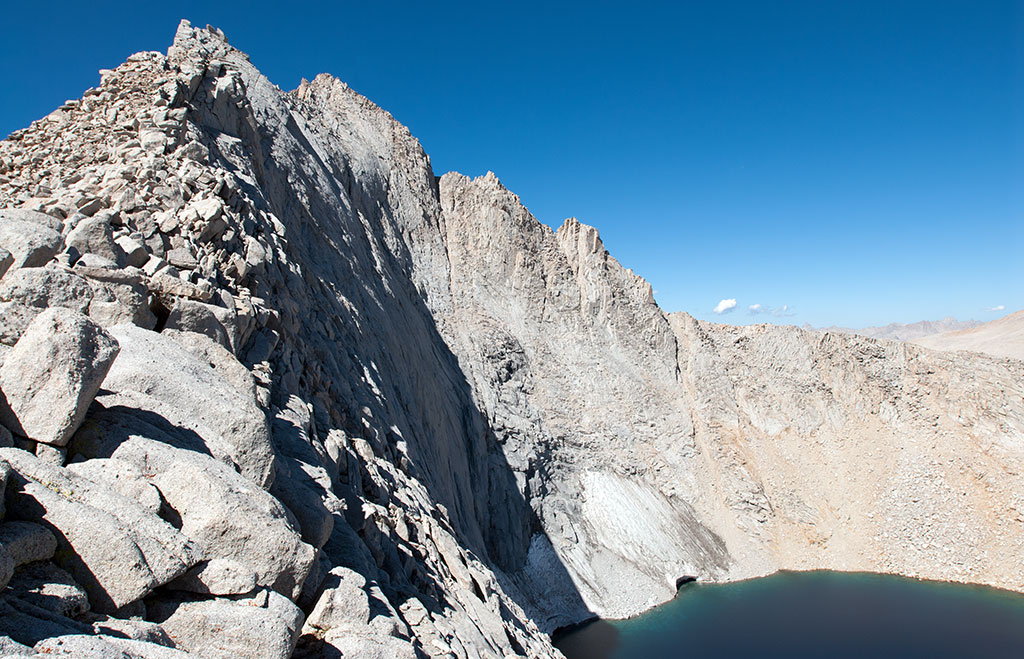
Whitey Portal, middle of the night. I can't sleep. I'm rolling back and forth in my sleeping bag, cold, trying to get comfortable, wishing I could just fast forward, put on my boots, get this over with.
I hate this part of the trip. The waiting. If I were alone I'd probably just get up now and start climbing. Even a crazy early start would be better than this fitful sleeplessness. And worst of all is the rumination. In my mind I'm mentally rehearsing all the tricky parts of the route ahead.
There are a lot of them.
For starters there is the North Fork approach. Branching off from the main trail to Mount Whitney, Lone Pine Creek's North Fork drainage is a willow-choked hell that can completely shut down a trip if you fail to navigate it correctly.
That's true even in winter. Snow will bury the willows higher up the drainage, if there's enough of it, but you won't know that until you climb it. And if you guess wrong at the bottom of the drainage, you'll be doing a lot of bushwhacking and backtracking.
Of course, that assumes I can even get us to the drainage. I want to take the original Whitney Trail, which is more direct, rather than the long switchback of the new trail, but now I'm wondering whether or not in the dark I'll be able to find it.
Should I bring a headlamp, just for the first 100 yards of the climb? Where is that damn trail, anyhow? And for that matter, when I wake up at 4:30 a.m., will I be able to poop?
I could be home in bed right now, sound asleep, cozy-comfortable. Tomorrow I could be sitting on my sofa, relaxing, sipping wine and watching TV. That sounds so much more logical than being here, cold, in the dark, wondering about...everything.
And I haven't even gotten to talking about what we're thinking about doing once we get up high.
God, I admire those mountaineers who don't seem plagued by constant bouts of introspection. That's one Freedom of the Hills that entirely escapes me. I'm a thinker. I'm a father. I'm a worrier. What the hell am I doing here, anyhow?
Is it time to get up yet?
The Whitney Zone
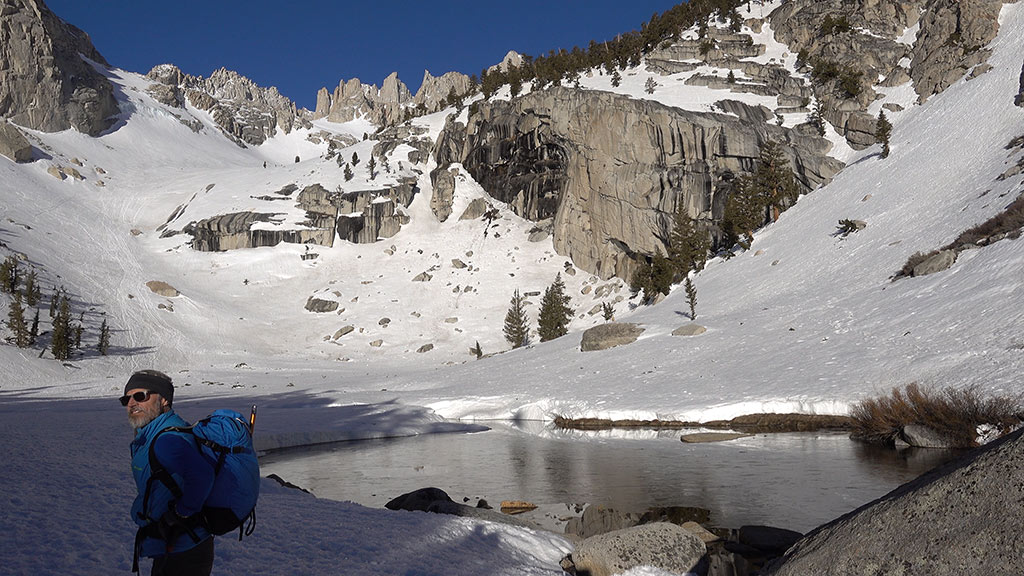
Preston's ski crampons make a comforting, ringing crunch on frozen morning snow as we ascend past Lower Boy Scout Lake, following, for now, the classic Mountaineer's Route.
The trials of the lower North Fork drainage are behind us. The sun is shining, the wind is calm, and I've already gently mocked Preston for his use of ski crampons, as Sierra tradition mandates. In front of us we have only easy skinning up the drainage until we near Upper Boy Scout Lake, where we'll head up the southeast face of Mount Carillon.
Mount Russell doesn't see a lot of ski descents.
It's hard to get to, compared to Whitney, and if you do get there, most of the mountain is likely to be bare, both because of wind exposure and also because Mount Russell is primarily just a big collection of cliffs and ridges.
The closest thing you'll find to an actual ski run is Russell's south face. When it holds snow, the south face is reasonably moderate (albeit incomplete), but like the rest of the mountain, the terrain is unfortunately proximate to Mount Whitney, who, prom queen that she is, tends to draw all the attention.
You can see evidence of Whitney's magnetism in the considerable boot pack hammered into the snow in front of us by who knows how many Whitney climbers already this year. Virtually none of those tracks lead to Russell.
That changes in summer, a little, when Russell's exceptional climbing routes draw those hardy few who can resist Whitney's pull. In winter, though, not so much. Come here then, with skis or without, and you'll likely find you have the mountain to yourself.
Russell-Carillon Col
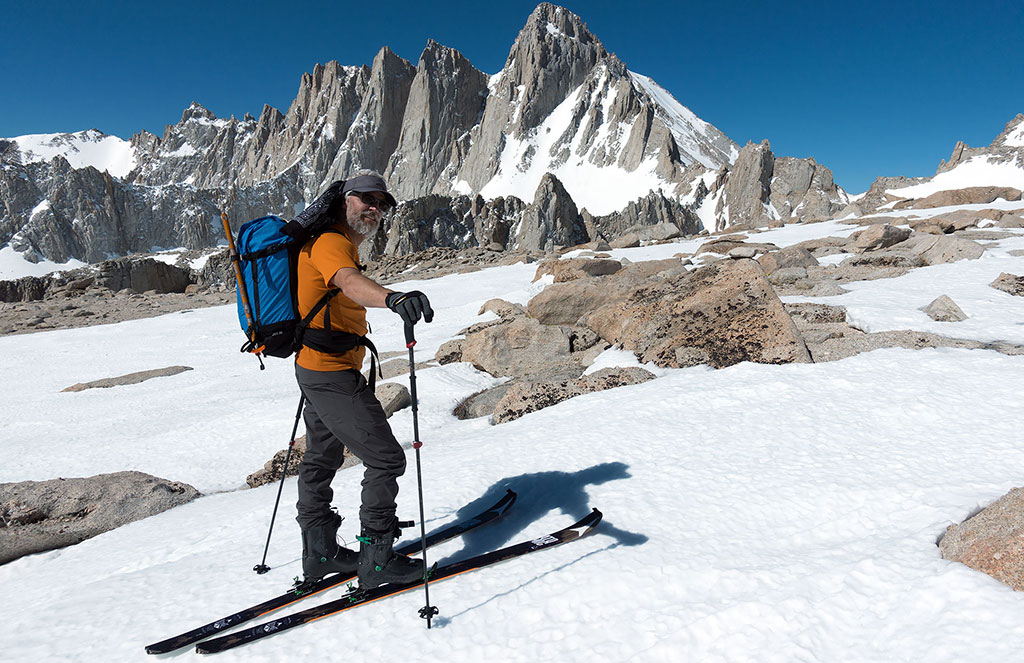
Famous neighbors: Mount Whitney
Carillon's southeast face proves to be a big climb, well over two thousand vertical feet. As we ascend the views grow ever more stupendous, offering a visual feast of Whitney Zone peaks including Lone Pine Peak, Thor Peak, Mount Irvine, Mount Langley, Mount McAdie, Mount Muir, and of course the lofty summit of Mount Whitney itself.
Along with the views I'm noticing truly exquisite spring snow beneath our feet. What was supposed to be merely an incidental part of today's route to Russell is suddenly looking like a spectacular ski descent on its own.
In fact, I'm starting to secretly hope the Russell-Carillon col will prove impassible, thus allowing me to argue we should abandon our Russell plans and just turn around and ski Carillon's southeast face right now, before it gets too mushy.
And then we top Russell-Carillon col and get our first look at Russell's northeast face.
There's snow there, top to bottom—first time I've ever seen that. A vague, gnawing anxiety grows in my belly. Maybe we should take a closer look at the headwall below the col, before we get ahead of ourselves.
To get to Russell from here, we have to leave Russell's east ridge, dropping toward Lake Tulainyo and in the process giving back nearly four hundred vertical feet—a painful descent after the long climb up Mount Carillon.
The headwall below the col looks like a big pain in the ass. I'd hoped it would be snow-covered. Instead, it's just a big line of cliffs and talus, definitely steep enough to cause trouble. We poke around a bit, scouting, and find what looks like a viable if not fantastic route through it.
Great. Looks like Carillon's snowfields will have to wait.
Going Soft
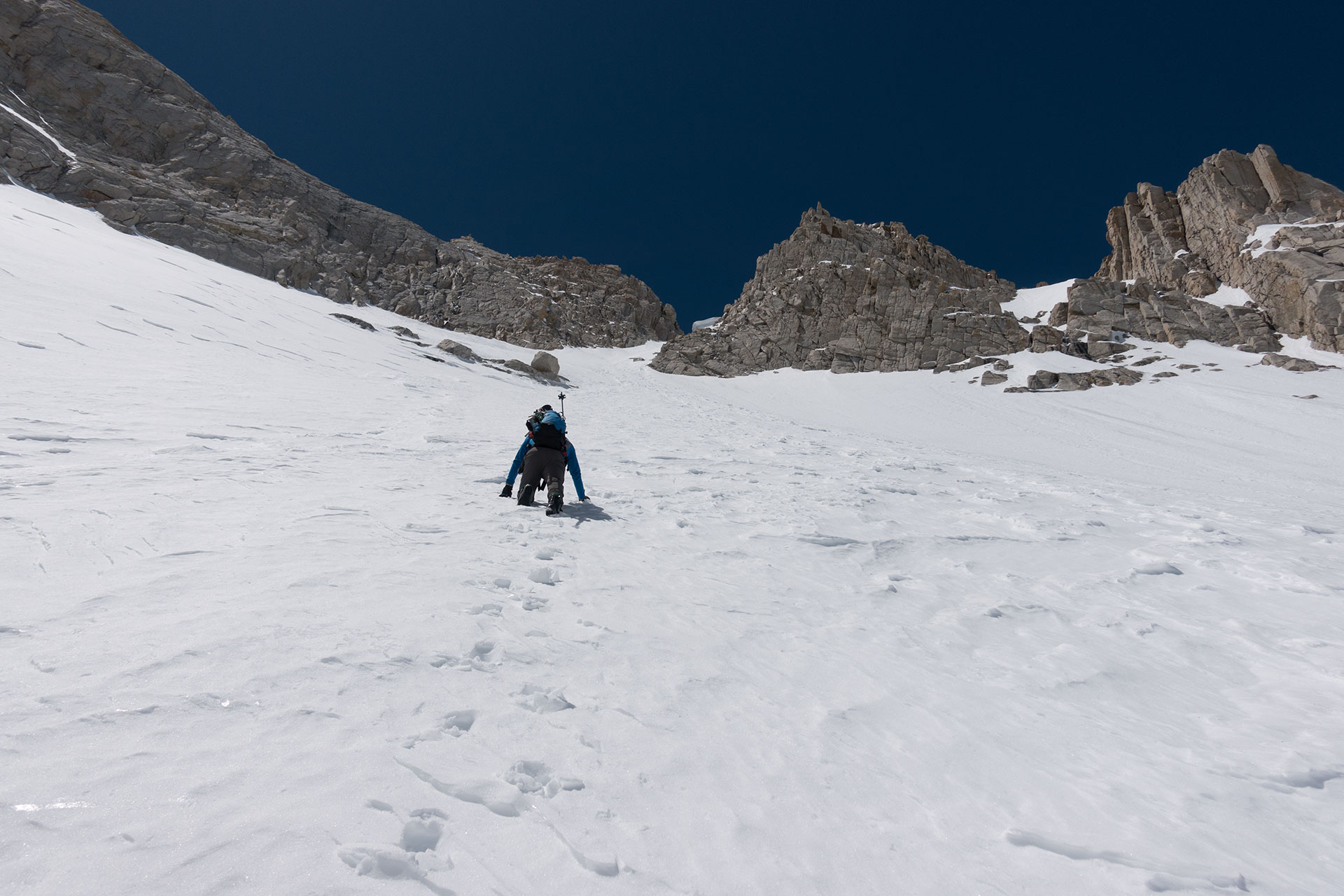
Andy Lewicky ascending Russell's Northeast Couloir
I haven't climbed or skied a route of consequence since 2011, when Dave Braun and I skied Mount Muir's east buttress, and for the most part, that's been fine with me. It's not at all clear whether or not I'm still that same skier who once made turns perched over Muir's thousand-foot cliffs.
I don't feel like I am; not anymore.
Having downclimbed from Russell-Carillon Col, Preston and I switch back to skis and skins and cross the wide basin around Lake Tulainyo, traversing around Mount Russell to take a quick peek at Russell's north face. We quickly decide we don't like the look of it.
That leaves the northeast couloir as the only remaining subject of debate. As we ponder whether or not to try to ski it, I tell Preston I've gone soft since Muir. He seems to find this comment amusing. But I'm serious: I'm trying to behave myself these days.
Funny story:
In the aftermath of that Muir trip, six years ago, I found my high-angle skiing skills lacking, to be honest. So I spent the next five years trying to teach myself how to make a better turn on the steeps—and I succeeded! But something happened over those same years, and not just the drought.
Having built the turn I needed to ski the super steeps, I began asking myself whether or not I should ski the super-steeps. That, to this day, remains an open question.
And so I am going soft, truthfully, even if that means I do occasionally find myself sinking an ice axe into 50+ degree snow and climbing towards fourteen thousand feet with skis on my back.
I mean...it's a process.
Ironically, Preston is a practicing psychologist, and you'd think given his profession he if anyone would be the Voice of Reason* out here. But no: when he's not helping others repair deep and intractable psychic wounds, Preston in his spare time likes to dance along the edge.
*(and here, Preston annotates by reminding me that Reason is an aspiration, and that most of our choices—or, as he puts it, our "choices"—are in fact heavily influenced by unconscious forces; alternately, he admits, "We are playing with fire.")
So here we are, climbing. I plunge my axe into the snow of the couloir, eying the steepness above, eying the exposure below, wondering not for the first time how exactly I got here.
It is steep. I've been trying to tell myself the pitch isn't so bad, maybe only 45°, but the steepness is so obvious, and so sustained, and we're barely a third of the way up this 1000-foot monster, and there is no question it gets steeper above.
The big lines, I find, leave you feeling like you're about to fall off the edge of the world.
That's exactly how I'm feeling right now. It's just an axe and the toes of my ski boots between me and the edge of infinity. Plunge, kick, step, plunge, kick, step. Up we go. Don't ask any more questions.
Skiing The Couloir
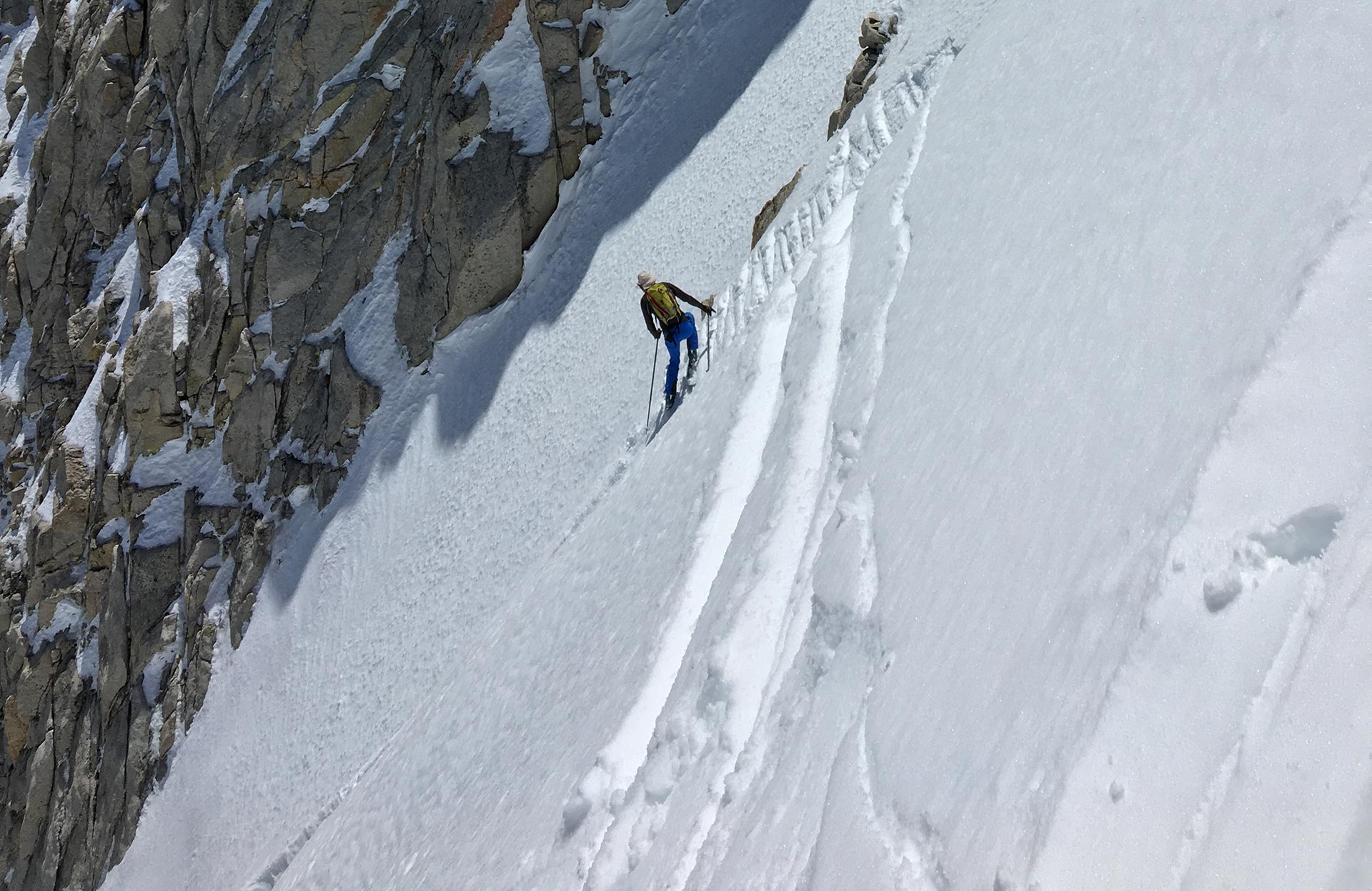
Photographs don't always tell the truth. A tilted camera lens tends to flatten a slope, but even if you get the perspective right, there's no way in two dimensions to see the terror I feel, nor is there any way to understand the exhilaration I feel as I drop over that edge.
A snow-covered cliff is still a cliff, after all.
Preston and I top out the couloir and take refuge on a small bench right around 13,800 feet, just off Mount Russell's east summit. Preston tells me he's feeling an incredible, dizzying sensation of vertigo.
Looking out at the crazy sweep of the east ridge, and the giant cliff-slab beneath it, is bending and twisting his ability to tell horizontal from vertical. I take his word on it; my own eyes are locked to the ground beneath my feet, where I set my pack and begin the process of switching to ski mode.
I don't want to spend any extra time up contemplating the void. Don't want to tighten up or (more likely) freak out.
So I snap into my bindings, verify boots are in ski mode, and with no further ado I'm traversing into the couloir, bouncing slightly, trying to get a feel for the snow.
It's immediately evident that the snow here is a good deal trickier than I would like. A little grabby, a little slabby. That big fin of granite to our south has kept the snow here more protected from the sun. Consequently, things are still transitional-wintery.
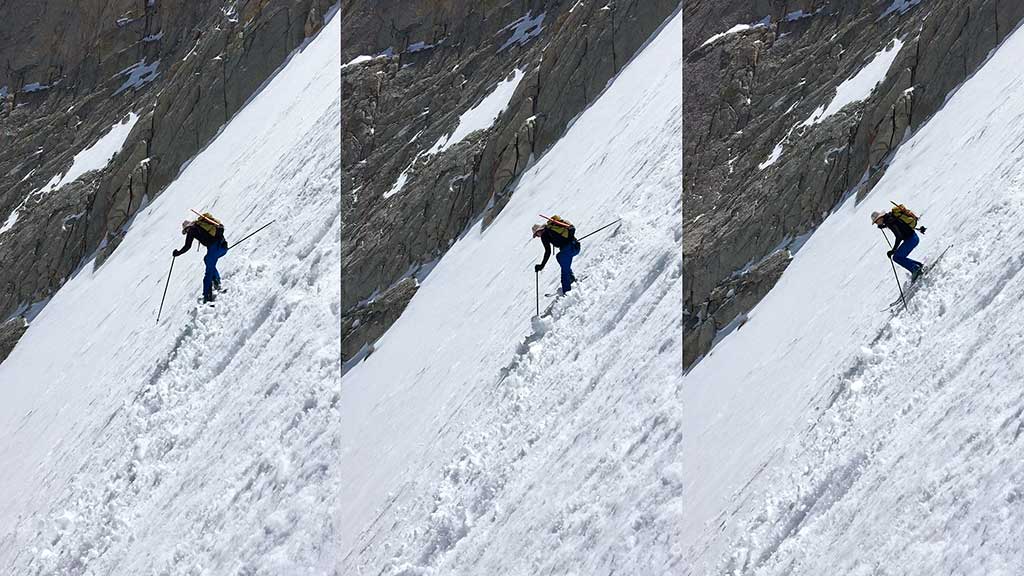
I traverse closer to the far wall of the couloir, expecting the snow to be a little firmer. It is, but the top layer still has an alarming tendency to peel off in little sections that knock about my feet.
I relay a bit of beta on the snow conditions to Preston and then it's time to make that first turn...there it is. Cliffs, vertigo, and death drops notwithstanding, what an extraordinary sensation it is to knock out a turn high atop Mount Russell's northeast face.
Down I go, methodically, taking my time, watching the sluff carefully in between turns, one after another, and it feels incredible. How can I even begin to describe the sensation of making controlled turns, here, on this face, in this setting, at this angle, on skis?
Maybe a third of the way down, I stop and anchor myself in to the slope with my ski poles so that I can take some shots of Preston. It's his turn. He, too, must contend with the sluff and the slabs and the grabby snow and the crazy-off-the-chart angle, and the cliff, but he, too, is loving it.
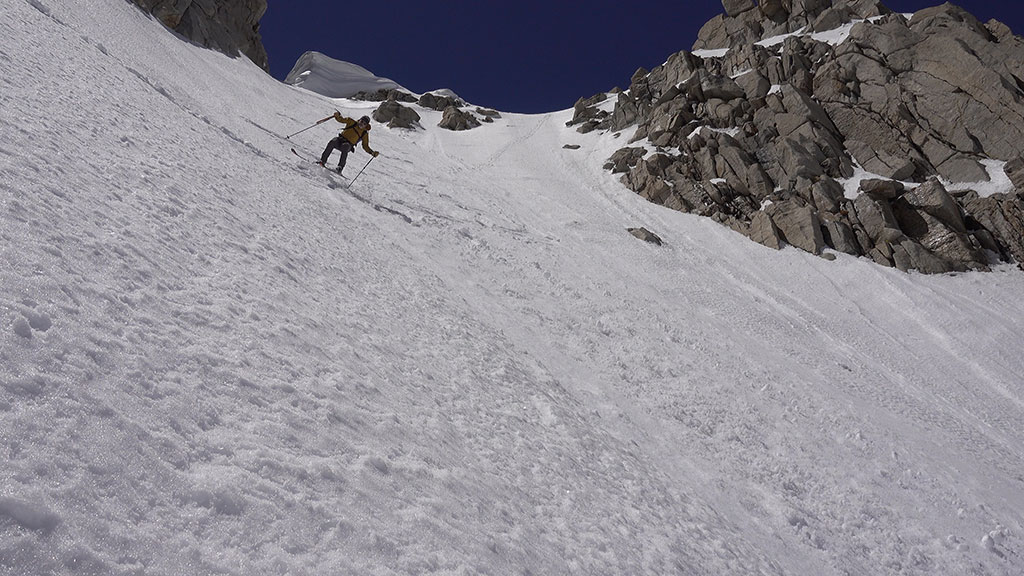
We are such helpless creatures. That is the truth of it, if you dare admit it. We bob along in an all-too brief stream of time, always at the mercy of nameless and faceless forces entirely beyond our control.
We cope by denying that reality. We cope by looking away. But sometimes, somehow, if you can stare into the void and shake your fist at it, you might just feel, in that borderland-moment, not quite so helpless.
It's insane, of course, to taunt the Reaper, but so too it seems insane to live without knowing what it feels like to dangle one foot over the edge. Then again, part of me insists we're always on that edge—we just don't realize it.
Regardless, right now I feel alive in a way I rarely experience when I'm back home, down in the Land of the Living.
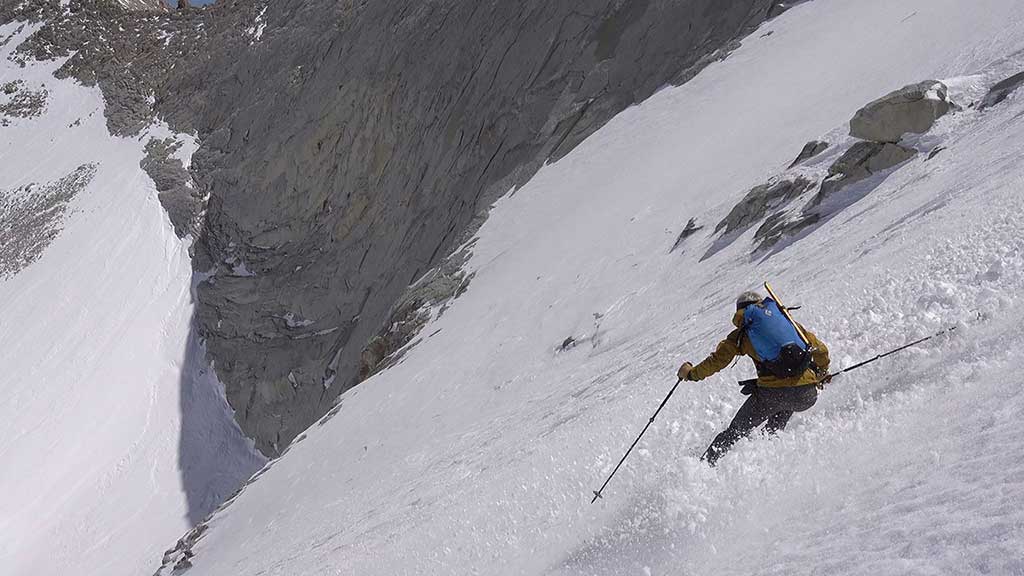
No doubt Preston would recommend therapy for a man afflicted with such thoughts. Perhaps more sessions with him, on another big peak, in the High Sierra? We'll have to check our calendars.
For now, we leapfrog each other down the slope's eternal steepness, nearing now the bottom of this adventure but not yet the end of this magnificent day.
When at the last the angle subsides, I run up my speed, making big GS turns, whooping and swooshing over the frozen lake hidden below Russell's northeast face. Then I stop and turn around, and this is what I see:
Return To The Land of the Living
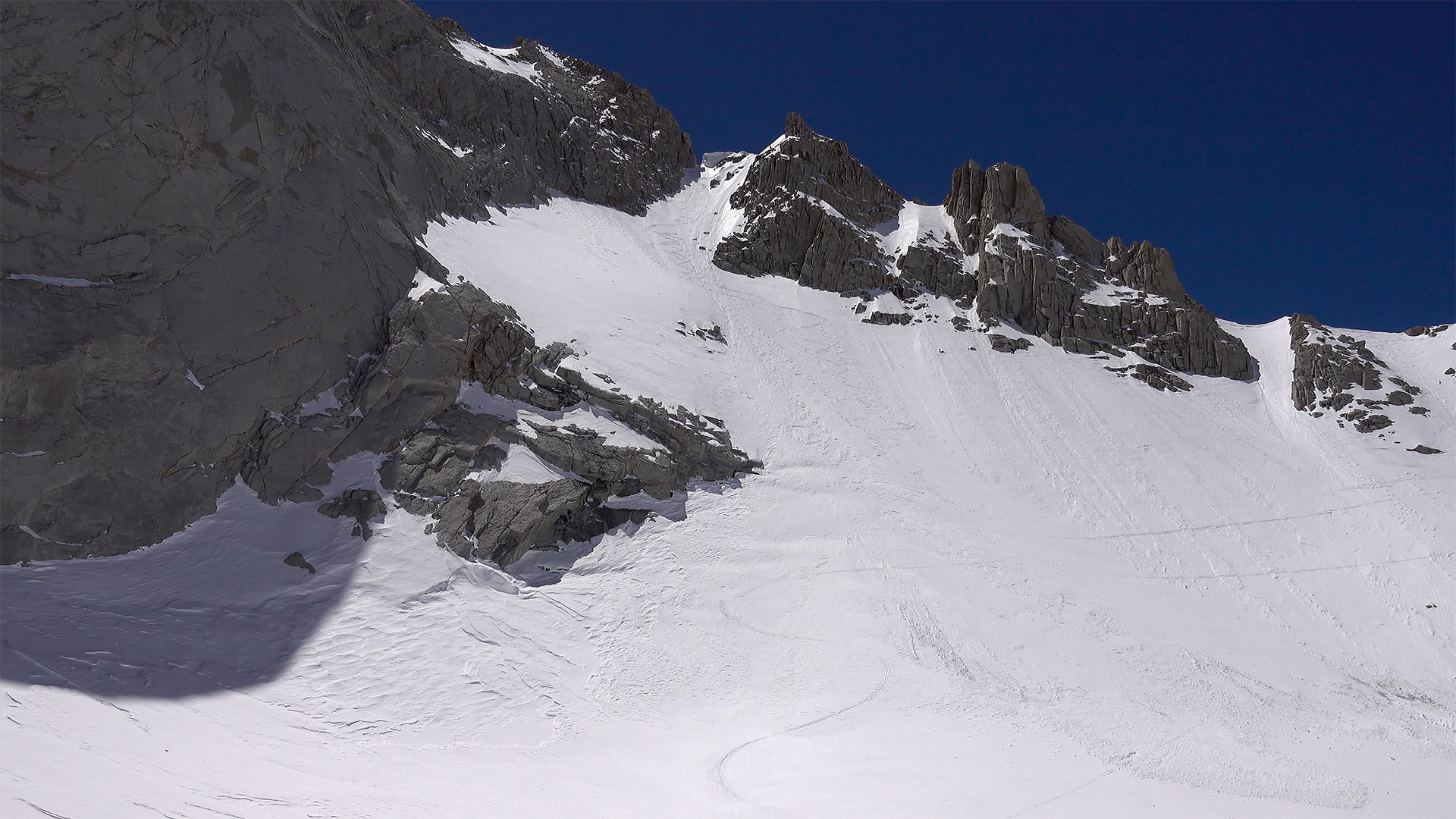
Russell's northeast couloir: Holy Crap!
Back at Russell-Carillon Col, elevation 13,250 feet, Preston and I rehydrate, chew some salt, and marvel at our burnt-out adrenal glands. Mount Whitney is to my right. To my left, Lone Pine Peak stands guard over Owens Valley and the road home.
Behind us, looming like a specter, is the madwall of Russell, our ski tracks plainly visible cutting back and forth across the peak's sheer northeast face. Maybe, I think, taking a careful peek at it, I'll look for something a little easier to ski next week.
I am going soft, after all.
My goodness, this cheese popcorn tastes delicious. Did you know we've still got the whole of Mount Carillon's southeast face to ski? I bet it's going to be really good. After what we've just done, how could it not be? I think everything's going to be good, for a good long while.
In any case, with apologies to John Muir, I feel the Call of the Valley. I'm ready to go home.
It would be nice if I could gather some pithy thoughts here, offer some sort of enlightenment, poke about at life's big questions. But all I see, all I feel, is a sense of mystery. I'm learning as I go, just like everybody else. And as for Russell and what we've done here today, I really don't know what to make of it.
But I will say this: there are many ways to have yourself an adventure, and skiing a big line on a big peak is not the only and certainly not the best way to go about doing it. If you can find the courage to scare yourself in the mountains, I encourage you to put that skill to work elsewhere, in your real life, where it counts.
That's what I'm trying to do, at least. As I said, it's a process.